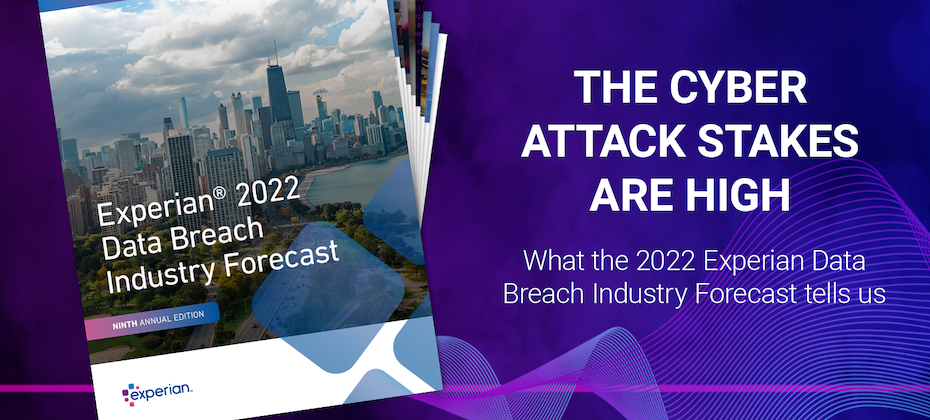Latest Posts

With consumers continuing to take a digital-first approach to everything from shopping to dating and investing, fraudsters are finding new and innovative ways to commit fraud. To help businesses anticipate and prepare for the road ahead, we created the 2022 Future of Fraud Forecast. Here are the fraud trends we expect to see over the coming year: Buy Now, Pay Never: Buy now, pay later lenders will see an uptick in identity theft and synthetic identity fraud. Beware of Cryptocurrency Scams: Fraudsters will set up cryptocurrency accounts to extract, store and funnel stolen funds, such as the billions of stimulus dollars swindled by criminals. Double the Trouble for Ransomware Attacks: Fraudsters will not only ask for a hefty ransom to cede control back to the companies they’ve hacked but also steal and leverage data from the hacked company. Love, Actually?: Romance scams will continue to see an uptick, with fraudsters asking victims for money or loans to cover fabricated travel costs, medical expenses and more. Digital Elder Abuse Will Rise: Older consumers and other vulnerable digital newbies will be hit with social engineering and account takeover fraud. “Businesses and consumers need to be aware of the creativity and agility that fraudsters are using today, especially in our digital-first world,” said Kathleen Peters, Chief Innovation Officer at Experian Decision Analytics in North America. “Experian continues to leverage data and advanced analytics to develop innovative solutions to help businesses prevent fraudulent behavior and protect consumers.” To learn more about how to protect your business and customers from rising fraud trends, download the Future of Fraud Forecast and check out Experian’s fraud prevention solutions. Future of Fraud Forecast Read Press Release

Credit plays a vital role in the lives of consumers and helps them meet important milestones – like getting a car and buying their own home. Unfortunately, not every creditworthy individual has equal access to financial services. In fact, 28 million adult Americans are credit invisible and another 21 million are considered unscorable.1 By leveraging expanded data sources, you can gain a more complete view of creditworthiness, make better decisions and empower consumers to more easily access financial opportunities. The state of credit access Credit is part of your financial power and helps you get the things you need. So, why are certain consumers excluded from the credit economy? There’s a host of reasons. They might have limited or no credit history, have dated or negative information within their credit file or be part of a historically disadvantaged group. For example, almost 30% of consumers in low-income neighborhoods are credit invisible and African and Hispanic Americans are less likely than White Americans to have access to mainstream financial services.2 By gaining further insight into consumer risk, you can facilitate first and second chances for borrowers who are increasingly being shut out of traditional credit offerings. Greater data, greater insights, greater growth Expanding access to credit benefits consumers and lenders alike. With a bigger pool of qualified applicants, you can grow your portfolio and help your community. The trick is doing so while continuing to mitigate risk – enter expanded data. Expanded data includes non-credit payments, demand deposit account (DDA) transactions, professional certifications, and foreign credit history, among other things. Using these data sources can drive greater visibility and transparency around inquiry and payment behaviors, enrich decisions across the entire customer lifecycle and allow lenders to better meet the financial needs of their current and future customers. Read our latest white paper for more insight into the vital role credit plays within our society and how you can increase financial access and opportunities in the communities you serve. Download now 1Data based on Oliver Wyman analysis using a random sample of consumers with Experian credit bureau records as of September 2020. Consumers are considered ‘credit invisible’ when they have no mainstream credit file at the credit bureaus and ‘unscorable’ when they have partial information in their mainstream credit file, but not enough to generate a conventional credit score. 2Credit Invisibles, The CFPB Office of Research, May 2015.

Creating a consumer experience where a customer receives a series of relevant and timely content is the goal of omnichannel marketing. OEM marketers work hard to develop effective marketing strategies that create fully integrated shopping experiences for customers. Build loyal relationships with omnichannel marketing Well designed, omnichannel marketing strategies foster a sense of relationship between the vehicle/brand and the consumer that can increase brand and dealership loyalty. Today's OEM marketers understand their customers are “everywhere.” Channels have exploded, especially in the past several years so marketers need to know how to best reach consumers. With multiple apps, websites, social media, email, streaming content, videos and brick-and-mortar dealerships the challenge for marketers is how to pull it all together. Recent research shows that 60% of millennials expect brands to provide consistent experiences across multiple channels and that Gen Z and Millennials are most likely to be “bought” by an effective omnichannel strategy.1 According to Forbes, “companies with the best omnichannel customer engagement strategies turn 89% of buyers into loyal customers. And according to Omnichannel Retail Statistics, companies with weak omnichannel strategies retain only 33% of their customers.”1 It is clear, that implementing an effective omnichannel strategy can result in more sales and increased loyalty. Use data insights to identify and segment audiences When approaching omnichannel marketing, we recommend OEM marketers conduct a detailed analysis, backed by automotive research and data. This analysis will help to accurately identify and segment audiences to deliver targeted, tailored content along the journey. Experian leverages our consumer, lender, and vehicle data along with market insights to facilitate powerful segmentation. As a result, OEM marketers can reach audiences in an effective manner allowing for a more personalized experience. For a deeper dive into segmentation, marketers can gain insights and understanding of key attributes using Experian’s CustomerView data. This data includes demographics, buyer personas, wants and needs, buying patterns, customer behavior, preferences, attitudes, and commonalities. These automotive data insights cover over 310 million U.S. consumers, 126 million households containing 1,500+ individual and household level attributes and 2500+ geographic attributes. This type of segmentation will help you create the right content for the right target group to be delivered at the right time in the right channel. If your message is irrelevant to the customer, or on the wrong channel, you just might lose engagement. Enlist the power of the Experian Marketing Engine™ to facilitate market insights, audience targeting, audience activation and measurement to monitor ongoing success. Learn how the Experian Marketing Engine can help you create audience segments that empower more effective omnichannel marketing today. 116 Proven Omnichannel Statistics That Will Boost Your Sales in 2021 (savemycent.com)

According to Experian’s State of Automotive Finance Market: Q3 2021 report, leasing comprised 24.03% of new vehicle financing in Q3 2021.

As we head into 2022 there continues to be heightened interest in auto auctions. Experian has observed a little cooling in auction activity in some parts of the western U.S., but the Central, Eastern and Southern geographies continue to see high unit activity, as depicted in the chart below. Let's take a look at how vehicle history data can help consignors make more informed decisions before auction. (Click here to access these insights directly). Review vehicle history data before auction assignment During this current climate, you can make the most of every auction (whether physical or digital) by reviewing vehicle history data before assignment. Have you ever brought inventory to a physical auction only to realize the vehicle had issues you didn’t know about? This can catch consignors off-guard and prove costly. So, how can you take advantage of vehicle history reports to help make better purchasing decisions? Vehicles with damage aren’t a lost cause, but rather consignors need to be strategic about where they send damaged vehicles to auctions to ensure the sale and maximize the sales price. A little extra research can help uncover hidden issues and vehicle damage. Vehicle history reports reviewed prior to auction assignment can assist consignors in uncovering vehicle damage and determine if the vehicles are appropriately priced to move before locking in their auction location. A quick review of the vehicle’s history report for major state title brands can reveal areas of concern and will also show other major problems, such as accidents, damage and total insurance loss. If damage or a major concern is uncovered, consignors can proactively evaluate the auction assignment. For example, the vehicle might have a better chance at selling in a hotter market like the Central, Southern, or Eastern U.S. than in a Midwest market. The key is to always know before you go by taking advantage of region and channel data to help ensure the most profitable sale. “Know before you go and tell before you sell,” says Joe Miller, VP of Client Experience at AutoIMS, the popular inventory management platform serving auctions and commercial consignors. “We continue to hear how vehicle history is influencing decisions not only about which auction to send the car to, but what repairs to perform, how best to floor price the car, and how to represent it in the lane. A new era of data-rich transparency is upon us in auto remarketing, and those tapping into the VHR will ultimately save time and make more money as they improve their reputation in the lanes.” By leveraging the Experian AutoCheck Vehicle History Report, consignors have quick and easy access to information that can help them make more informed, profitable decisions. To become an AutoCheck Vehicle History Report subscriber, sign up today.

New Year, New Cyber Threats This is my first blog post of 2022, and I’m afraid the news I’m here to bear isn’t ideal: cyber attack stakes are high. In 2022, hackers are literally betting on a growing market spreading online across the U.S. Before I get into our Data Breach Industry Forecast, let’s take a quick look back. In 2021, we witnessed a sea of change in digital connectivity and activity during the pandemic. As vaccines became widely available and distributed, the recovery, on all fronts, felt close. But now, as new variants continue to develop and spread, it seems like we are in a one-step-forward, two-steps-back scenario—what the Ninth Annual Experian Data Breach Industry Forecast calls the “Cyberdemic Hangover.” As we aim for stability in 2022, companies must continue to secure weak technologies, and consumers must be vigilant in their daily digital lives. The 2022 Data Breach Industry Forecast report tells the story of what we’re facing this year better than I can, so I encourage you to download a copy. However, here’s a preview of one prediction to get you started. Hackers Bet on New Gamblers Again, cyber attack stakes are high. The online gambling market reached more than $70 billion globally in 2021. With more U.S. states legalizing online sports, cyber thieves will look to place scams, particularly phishing scams, on the likes of fantasy sports sites and more. The possible targets will add up over the course of the year as this market grows and alternative payments like cryptocurrency become more widely accepted. Experian’s deep expertise in helping companies navigate more breaches over the last 18 years informs the other four predictions. To find out the other areas hackers are hoping to cash in on this year, download the predictions now. Visit our website for Data Breach Resolution and Reserved Response™ insights

In Q3 2021, the average new vehicle loan amount increased 8.5% year-over-year, while the average used vehicle loan jumped more than 20% year-over year.

Successful salespeople know that their busiest time is never when they are selling a lot of cars. They are way busier when they are not selling! The act of prospecting, following up, and consultatively selling is a time consuming and challenging process. Nevertheless, for salespeople, this pattern can lead to long term success in automotive sales. Until the inventory and chip shortage issues are resolved, you may find that you are busier than ever. You can no longer wait to greet shoppers as they walk into the show room and spend time chatting and test driving in hopes they will purchase a vehicle the same day. Floor traffic has been on a steady decline for a decade and with today’s vastly reduced inventory there is vastly reduced foot traffic. This does not mean that you should not or cannot sell cars. It means that your time should be filled with prospecting, following up on marketing leads and focusing on the dealership’s loyal customers. Focus on strategies that drive pre-orders In addition to prospecting activities, you will need to be extra resourceful during the sales process. For example, when the dealership does not have a specifically requested car on the lot, you should shift focus from the standard sign-and-drive approach to a focus on pre-ordering vehicles. Pre-orders can be attractive to customers because they give them the ability to create a new vehicle according to their color, options, and other preferences rather than settling for whatever the dealer has in stock (which right now is minimal at best). Experian’s Automotive Intelligence Engine™ (AIE), a fully customizable suite of marketing solutions can provide you and your dealership with the data insights necessary to find consumers who would be interested in your brand and models and who are in an equity position to facilitate a pre-order. Here are a few examples of how AIE helps dealers find likely pre-order consumers: Scenario: A Mercedes dealership would like to secure pre-orders and generate interest in vehicles for when inventory becomes available in 2022. Utilize AIE’s Market Insights to find lifestyle and demographic information to find consumers with a high buying propensity to purchase a luxury vehicle. Use AIE’s Audience Targeting to learn who of those consumers are in a positive equity position. Identify consumers who are likely to buy your models based on their prior purchasing history. Using marketing solutions to help find the right consumer now to create interest in the future could be the key to success in 2022. Focus on short term leases opportunities In today’s market, we also recommend dealers focus on targeting consumers who are nearing the term of their lease—because the end of a lease forces consumers to either turn in the vehicle or purchase it. In many cases, the customer can upgrade to a model with more features or a model in a different class—both of which may be compelling, even if the newer vehicle is an older model year than the trade in. This way, the dealer obtains the later model, lower mileage vehicle and the customer gets a model with the extra features they want or an entirely new class of vehicle. The Automotive Intelligence Engine can provide dealers with near term lease consumers in their area for all brands. For an in depth look at this topic, read our November blog “Using Data Insights to Focus on Near-Term Lease Sales Opportunities.” Learn more about Experian’s Automotive Intelligence Engine.

There are over 280M cars and light duty trucks on the road and over 25% have at least one open recall. Do you know which of your online units have an open recall? Would it be helpful to your business if you had up-to-date recall information available every day—automatically? AutoCheck® dealerships can receive an emailed daily Open Recall Inventory Check Report as part of their AutoCheck subscription. The report (PDF format) will show dealers which of their online listings have an open recall. The report will list inventory that has open recall(s) based on pre-owned vehicles the dealer has listed on AutoCheck.com. Having an easily reviewable report delivered to your Inbox is a great way to stay on top of internal recall policies and procedures. Taking care of open recalls is good for business Taking action on recalls is also good for business. Consumers searching your online inventory want transparency from their dealer and running across a vehicle that has an open recall may not be in the dealer’s best interest. Taking care of that recall and ensuring that a consumer doesn’t stumble across it during the purchase process is good for consumer loyalty. Another AutoCheck dealer benefit is the option to list pre-owned inventory on CarZing and AutoCheck.com for no additional fee. AutoCheck is the exclusive vehicle history report provider on CarZing.com, so the CarZing vehicle details page will display both AutoCheck data elements and provide a link to the full AutoCheck report. Any AutoCheck dealer displaying their inventory on CarZing will automatically have their inventory available via the “Finding Vehicles” search features on AutoCheck.com. (Yes, you read that correctly – dealers can list their inventory on CarZing and AutoCheck.com for NO additional fee – it’s part of their AutoCheck subscription!) In addition, any dealer listing their inventory on AutoCheck.com can also receive the AutoCheck Open Recall Inventory Check report. Please note that Experian provides the AutoCheck Open Recall Inventory Check Report based upon recall information reported and made available to Experian by the applicable automotive manufacturer(s). Clients should check the automotive manufacturer’s website for the most current recall information for all inventory vehicles. For dealers with an AutoCheck subscription, you can activate your vehicle listings for free on AutoCheck.com and CarZing.com, by calling client services at 1 888 409 2204. For dealers that are not yet subscribers, here’s a few other things you may not know about AutoCheck Vehicle History Reports. We do not re-market to shoppers, resell VDP leads or offer your competitors inventory for consideration on AutoCheck.com. Our goal is to help your dealership sell your inventory. For dealers who are interested in learning more about the benefits of becoming an AutoCheck subscriber contact us today.

Who said that direct mail was dead? Though consumers have flooded to digital channels since the onset of the pandemic, with 55% now having a higher expectation of their customer experience, traditional methods shouldn't be cast aside. On the other hand, sending printed mail without adapting to consumer demands may leave recipients disengaged and less likely to act. So, where does that leave marketers? How can businesses create a balance between traditional and digital credit marketing? Before diving into that discussion, it’s important to note that direct mail is still effective and when done right, can help businesses win the hearts and wallets of today’s consumers. According to the U.S. Postal Service’s (USPS) Certified Direct Mail Professional (CDMP) program, 79% of households say they read their daily mail, while 70% of recipients are curious to find out what’s in their mailbox. So, how can credit card marketers capitalize on these trends to generate higher response rates and returns from their direct mail campaigns? It’s simple – businesses must weave interactive elements and technology into their direct mail pieces to make them more effective and engaging. Here’s how credit card issuers are leveraging technology to level up their direct mail campaigns: QR codes QR codes, which allow consumers to read restaurant menus and make touchless payments with their mobile devices, have become a global sensation, with the number of interactions having grown 94% between 2018-2020. More recently, credit card marketers have included interactive QR codes into their direct mail pieces, allowing recipients to learn more about the offer, download their mobile app or quickly apply for a credit card. A few brands took it a step further by matching their QR codes with the colors of their logos to add more brand recognition and personalization. Voice Activated Call to Action (VACTA) According to Mintel, over 25% of U.S. adults own at least one smart speaker. To capitalize on this trend, many credit card issuers have included a Voice Activated Call to Action (VACTA) in their direct mail pieces. A VACTA allows recipients to respond to direct mail offers verbally by using their Amazon Alexa or Google Assistant device. Instead of reaching for their smartphones or laptops, consumers can call out to their smart speaker with the offer code. This low-effort, hands-free method is a quick and convenient way for consumers to engage with businesses as it enables them to respond to offers even when they are performing other tasks. Once their smart speaker receives the code, a link is then sent to the consumer’s phone so that they can examine the offer at any time. Giving consumers more flexibility enhances their experience and increases the chances of them responding to future offers. Additionally, including a VACTA in direct mail pieces allows marketers to manage, track and optimize their marketing campaigns in real-time. Because VACTAs make offers immediately redeemable, businesses can easily measure the performance and effectiveness of each direct mail piece. Informed Delivery emails What better way to build anticipation and excitement for direct mail offers than to give consumers a sneak peek of what’s to come? USPS’s Informed Delivery is a service that allows consumers to digitally preview their direct mail before it arrives in their physical mailbox. Until the physical mail piece is delivered, consumers can look at what the mailing might reveal or offer to them through email, an online dashboard or a mobile app. The best part? Informed Delivery emails meet today’s consumer expectations for convenient digital experiences as they are available to view them anytime, anywhere. Currently, one in five households has an Informed Delivery participant. What’s more, the average open rate for an Informed Delivery email is nearly 70%. By incorporating Informed Delivery into direct mail campaigns, businesses can generate additional impressions, improve customer engagement and drive more conversions. Doing direct mail, the right way Direct mail isn’t outdated, antique or ineffective – it has evolved and adapted to meet the expectations of today’s consumers. The use of QR codes, VACTA and USPS Informed Delivery, are just a few examples of how credit card marketers are leveraging digital enhancements to improve the success of their direct mail campaigns. While it’s clear that direct mail is still an effective way to reach consumers, businesses should not overlook the power of digital marketing. Expectations for seamless and connected digital experiences are higher than ever, making it crucial for businesses to develop strong digital marketing strategies. By engaging with consumers in the way that works best for them, with the right messages at the right time, you can drive more opportunities, reduce costs and deliver exceptional customer experiences. Learn more Download white paper

Experian was recently named a global fintech leader in the Center for Financial Professionals (CeFPro) Fintech Leaders 2022 report, ranking among the report’s top companies within the Credit Risk and Fraud Prevention categories, and in the top 15 Overall Ecosystem Rankings, rising five places from 2021. This award comes at a time where fraud and identity management services are of utmost importance given the rise of digital channels and activity; and as risk management strategies continue to be a priority – especially in times of economic volatility. “This recognition as a fintech leader by industry peers is a testament to how Experian partners with businesses and consumers to enable fintechs with innovative solutions and insights to mitigate credit risk and make better decisions,” said Jon Bailey, Vice President of Fintech at Experian. “Despite times of rapid change, Experian has been and remains committed to focusing on helping our clients with a wide range of challenges by providing valuable solutions. It’s great to see our continued efforts and investments driving positive impact. We will continue to invest and innovate to enable our clients for growth and create opportunities to support their customer-first missions.” Over the past year, Experian has placed bets on helping open-up credit to underserved communities, adapting to changing consumer expectations, addressing the growing threat from fraud, and becoming a more agile technology provider in an ever-changing market while helping clients mitigate credit risk. To learn more about Experian’s solutions that power fintechs, visit our fintech solutions page here. Click here for the full press release and to read more about the award.

Experian’s newest Global Insights Report found that consumers are online 25% more today than they were just a year ago, highlighting the importance of the digital customer experience. To acquire customers and retain their loyalty, businesses need to focus on improving the online experience, preventing fraud, and managing credit risk. This September, Experian surveyed 3,000 consumers and 900 businesses across all industries to explore business priorities and recent changes in consumer activities. Many businesses and consumers are reportedly feeling more economically stable now than they were a year ago. As consumers resume spending the digital customer experience becomes even more paramount – requiring businesses to invest in scalable software solutions that will accurately assess credit risk and meet ever-changing needs and priorities. Our research found that: 42% of consumers have increased concern for the safety of banking and shopping transactions Business adoption of advanced analytics has increased over last year, and adoption of artificial intelligence is up from 69% to 74% Consumers are more likely to share their personal data if it improves their experience, with 56% willing to share their contact information The top three consumer priorities continue to be security, privacy and convenience Download the report to get all the latest insights into consumer desires and business behaviors as we move further through the digital evolution. Download the report

Credit scores play a massive role in a consumer’s financial life as they help determine an individual’s creditworthiness. While 62% of consumers are interested in improving their credit scores, a troublingly high percentage are unsure of where to start. What’s more, one in four Americans have no idea how credit scores are even determined. This knowledge gap presents an opportunity for financial institutions to help consumers increase their credit understanding and establish lasting relationships. Some of the benefits of providing credit education to consumers include: Consumer trust and loyalty Today’s consumers are looking for guidance and support on all things credit. Helping consumers navigate their credit reports, improve their credit scores and explore the impacts of various scenarios are all opportunities for financial institutions to meet this demand and foster loyalty. With the knowledge and tools needed to make confident and responsible financial decisions, consumers will continue to trust and look toward the same financial institutions for credit guidance as they navigate their financial journeys. Credit education is especially valuable to younger consumers. As rookies to the credit game, many Gen Zers may find credit to be mysterious, complex and difficult to grasp. Despite these feelings, Gen Zers have shown considerable interest in becoming financially literate. By continuously providing Gen Z consumers with reliable and accessible credit education early on, financial institutions can grow to become their valuable partner, educator and mentor for life. More cross-sell opportunities The more educational resources financial institutions provide their consumers, the more likely they are to pay their credit card bills on time, take out loans and mortgages they can meet and purchase within their buying power, making them prime candidates to approach for additional credit offerings. According to studies conducted by Visa Performance Solutions, consumers respond more to credit offers from institutions they currently have a relationship with than those they don’t. By providing credit education and relevant offers to existing customers, financial institutions can improve satisfaction while increasing their revenue. Enhances brand reputation While credit education allows financial institutions to strengthen their relationships with existing clients, it also gives them an opportunity to expand and acquire new ones. When consumers feel valued and cared for, they are more likely to recommend a business’s products and services to someone else. The more consumers see how much a financial institution invests in their customers’ financial well-being, the more likely they are to convert themselves. Ready to get started? Providing value to consumers is no longer just about offering great products and services; it’s about helping them understand the basics and importance of credit so that achieving their financial goals comes easily. To learn more about how credit education can help deepen customer relationships and drive business growth, visit our Experian Partners Solutions page. Learn more

While dealers wait out the chip shortage, many are looking for new revenue streams and creative ways to maintain profit levels. Dealers understand that used vehicles are more valuable than ever and that savvy consumers who are near their lease term can purchase their vehicle with a much higher book value than their negotiated residual and capitalize on that extra equity. At Experian Automotive, we help dealers analyze consumer and market data insights so they can develop marketing strategies that more effectively engage consumers. In today’s market, we recommend dealers focus on targeting consumers who are nearing the term of their lease—because the end of a lease forces consumers to either turn in the vehicle or purchase it—and many consumers realize they can purchase their equity rich vehicle and trade it in anywhere. Dealers desiring to conquest customers would benefit from using data insights to develop marketing strategies to help educate consumers of their options. So, how do dealers make sure their lease customers remain loyal to their dealership? One way is to target those customers that are near term and recommend a trade in. In many cases, the customer can upgrade to a model with more features or a model in a different class—both of which may be compelling, even if the newer vehicle is an older model year than the trade in. This way, the dealer obtains the later model, lower mileage vehicle and the customer gets a model with the extra features they want or an entirely new class of vehicle. Both parties are happy. What about third party lease buy outs? In response to the inventory shortage, many captive lenders are no longer permitting 3rd party lease buy outs. In other words, consumers are required to purchase their leased vehicle at an in-brand dealership. Initially, this would appear to bolster brand loyalty by making it more challenging to switch brands. However, educated consumers know they can simply purchase the vehicle and drive it to another dealership as a trade. We recommend automotive dealers educate consumers on their options through effective marketing strategies that offer options and more freedom in their car purchasing. Dealers looking for every sales opportunity are utilizing data sources such as Experian’s Automotive Intelligence Engine™ (AIE) to identify all consumers with leased vehicles for their brands. Because the OEM will not share lease customer information for neighboring stores, dealers must seek out this information on their own. Experian’s Automotive Intelligence Engine provides off lease consumer information for conquest brands as well as dealer brands. The OEM still expects each store to be successful and using data-driven insights to uncover opportunities in this tight market is one critical way dealers can stay competitive and increase brand loyalty. The chip shortage will eventually recede but until then dealers can use automotive data insights that can help them remain profitable. Learn more about Experian’s Automotive Intelligence Engine.

Hackers are playing the game of data compromise, and they are winning. At this point, companies of all sizes, from all industries, know that consumers have a growing desire to take control of their data and digital privacy. In case you missed the latest webinar and whitepaper release from Javelin Strategy & Research, it makes three things clear about consumers’ current attitudes about fraud and its impact on businesses. 1. Consumers are much more privacy-aware In 2020, consumers turned to social media and telecommunicating platforms to work, stay in touch with friends and family networks and learn. While the broad-scale increase provided a way for global commerce and connections to continue during the worldwide pandemic, it also accelerated cybercrime. The influx of internet traffic created a ready-made environment for fraudsters to profit from consumers in a big way, primarily through scams. Scams were so profitable that they accounted for $43 billion of the $56 billion reported ID fraud losses last year.1 2. Consumers blame Financial Institutions for fraud. It’s the main reason they leave. When consumers experience fraud, they blame their financial institutions, even if the loss has nothing to do with the institution or its business’s responsibility to the consumer. This attitude shows that consumers hold FIs accountable for their data protection. And when they don’t get it, they take their expectations and their business elsewhere. The data shows the proof. In 2020, 38% of consumers closed a bank account affected by fraud, with 69% saying their primary FIs did not resolve their fraud concerns or losses.1 As the saying goes, perception is reality, and in the case of fraud, consumer thoughts have real consequences for organizations. 3. Consumers leave when breaches happen This point is simple: consumers leave even when personally identifiable information (PII) or other data is not stolen. Be prepared with a playbook or be ready to lose consumer trust To improve the customer experience, build trust and reduce risk, companies need a playbook — a fraud resolution and breach response playbook — a solid plan that falls under their existing business and continuity disaster recovery plan. Why? Because consumers need to know and, more importantly, trust that companies are prepared to react quickly and deliver resolution when a network intrusion occurs. According to Javelin Strategy & Research data, fraud resolution is the best way to retain customers and members. In addition, consumer perception of cybersecurity plays a significant role in consumer attrition and retention. Again, even if personal information is protected, if your organization is attacked, consumers are more likely to stop doing business with your organization, even if no data was compromised. This means cybersecurity and fraud prevention empowerment is a game-changer, driving 22% of consumers’ satisfaction ratings with online banking.2 When building your playbook, consider two core things: 1. Make sure it’s well-developed A comprehensive fraud resolution and breach response should include a solid approach to collaborate with consumers when fraud occurs. Ensuring your plan includes fraud, cyber, and marketing communications teams will help your company act swiftly and build consumer confidence. 2. Don’t just encrypt data; strengthen perimeter security. Strong perimeter security will ensure safe interactions with consumers. Even if personal information is protected, consumers will perceive a penetration of the network as a breach and will be more apt to stop doing business with your company. At Experian, preparedness is our business. We know how important fraud resolution and breach response is to your customer’s experience. Developing a solid playbook is key to that experience, building trust and reducing risk. To learn more, read the Giving Consumers Control and Enhancing Fraud Prevention whitepaper, watch the Empowerment and Fraud Prevention are Key webinar and find out how to protect your business with Experian’s Global Data Breach Solutions. 1 Javelin Strategy & Research. March 2021. 2 Javelin Strategy & Research. June 2021.